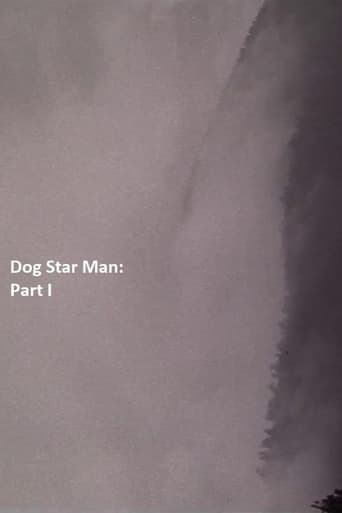cinephile-27690
Like Wavelength, nothing happens.
Skip this movie!
The "best" part is the random topless woman.
Oh, and there's a mountain climber.
Well that's it.
Don't see this movie?
Have you seen....any other movie?
Can you name one?
Go see that instead!
MisterWhiplash
With this 'first' part of Dog Star Man (I'd say you should watch the Prelude before this, but I don't buy that there's exactly a strong 'continuity' here, this isn't the Marvel universe or something), we get more of a narrative this time. By 'more' I mean that there is at least a character of a sort - a rugged man (Brakhage himself) climbing up a mountain. Ala that song by Chumbawumba (remember that one, yes I went there), he gets knocked down and then he gets back up again, and his visions won't keep him down. That is, if they are visions.This time there are more steady shots that last longer than the half a second or less that we got in the Prelude section, and yet in a strange way I wish it was *more* abstract. Because of there being "character" or a person or whatever, there's some expectation set up, at least for me, for more to go on. What we get is the furious, rapid-fire and stream of consciousness approach to imagery, where things go by so far I visage about 100 images in 20 seconds, and then it goes back briefly to slow-motion shots of the man climbing ever so slowly up the mountainside. Sometimes the dog is there and sometimes not.Maybe it makes the most sense as this section being like some abstract documentary of what it takes to climb up a mountain, and if you're in a mood that is rather infuriating your mind will go at a very fast clip across images and sights and things that may be unspeakable. That's what this series is strongest as it approaching things like red membranes where cells and tiny organs pulsate, and the sun, shot with a lens that makes it look up close and personal, is imposing in some way that is far off but close at the same time.And yet for all of the strong passages, I think having the man going up the hill, for as long as this movie is (30 minutes), makes it more monotonous. At least with the Prelude you didn't know what to expect, and it's more of a journey through someone's subconscious or unconscious. Here it's a mix of both this less-than-bare-bones scenario of a man on the mountain (albeit personal to Brakhage, who was out of work at the time with kids and one on the way, and this feels like a battle to persevere), and the abstract stream. It works, but not to where it's as outstanding as the Prelude.
schachtmant
This 5-part montage is clearly a technical masterpiece, but like most surreal art pieces, it is dangerous to conceptualize with any confidence. It is highly recommended that that viewer experience all five parrts as they are certainly related. Although I am ignorant of the technical aspects of filmmaking, this film surely is mandatory viewing for film students since it appears to use every trick in the book for imagery-based, fast-cut filmmaking. Conceptually (as one viewer's take on the film), the film is about a young male in a cold, snowy alpine-like setting and his dog as they work their way along through the cold, harsh, dangerous elements. We experience what hapens in the mind and body of this individual during the ordeal, including scenes of the outdoors, biomedical footage of the inner workings of the body's tissue and organs, interactions between this man and a woman's body, his dog, celestial shots, the birth and first year of a new born baby. All of this is put together with great artistic talent (I was often reminded of work by Paranjanov, Tartovsky and Greenaway but I am not sure that any connection is warranted anywhere except in my own reaction) and depicts one man's fast-paced struggle with all of these experiences. The full-length feature is long and taxes one's attention, but the journey is worth it for those willing to take such an adventure.
BlueNeon-2
The trouble with Brakhage, and most avant-garde film, is that, while experimentation is valuable to the artist, it isn't necessarily art in itself. This 60's film is simply an experiment in visual manipulation, which occasionally has some interesting ideas that go nowhere in particular. The division of the film into sections seems unnecessary and, as far as I can tell, follows no particular reasoning. If you're on acid, you might love this film. If you're a filmmaker, you might find it interesting here and there. In general, however, it's not worth the time.
